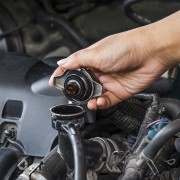Without a working radiator your car is as good as toast. If you suspect a leak in your car's rad, here are four steps to spotting and repairing it before the engine overheats.
- Browse Categories
- All Tips
-
Home & Garden
- All
- Appliances
- Bathroom
- Cleaning
- Crafts
- Decorating
- Electrical
- Flooring
- Furniture
- Garage Door
- Gardening
- Green Living
- Heating
- Home Alarm Systems
- Home Maintenance
- Home Remedies
- Home Security
- Home Staging
- House Sitting
- Junk Removal
- Kitchen
- Lawn Care
- Lock Systems
- Moving
- Outdoor Living
- Pest Control
- Plumbing
- Renovation
- Roofing
- Snow Removal
- Storage
- Tools
- Tree Service
- Health
- Family
- Travel
- Auto
- More Tips

4 steps to spotting and repairing an auto radiator leak
November 19, 2014

How does a radiator work?
Constructed with slim, hollow channels, the radiator sits at the front of your engine.
- Liquid coolant is pumped from the radiator through tubes to the running motor, where it draws off heat.
- Pumped back to the radiator, hot coolant is then cooled by air passing through the grill as the car moves.
- The coolant then cycles back through the engine to repeat the cycle and keep it working at an optimal temperature.
Basically, without a radiator—and engine coolant—your engine will overheat.
Step 1: Spot the leak
One sign your radiator is leaking is if a pool of green, yellow, or orange coolant shows up under your car. Sometimes all you may find are a few drops. Other times it may be an actual puddle.
- Another sign is your temperature gauge if it's indicating that your car is overheating.
- Sometimes you may see steam rising from the radiator, indicating a pinhole leak or ruptured seam. If the leak isn’t readily apparent, wash down the radiator and its hoses with water and watch for the leak as the motor runs.
A word of caution when inspecting your car's engine: parts of the motor will be extremely hot and could cause burns or scalding. Always exercise extreme caution when looking for leaks in your car's cooling system!
2. Inspect the parts
The radiator should be inspected for cracks, broken fins, and crusty coolant leaks.
- All hoses, including heater core hoses, should be checked for collapsing or swelling. Crusty coolant on the outside of hoses or connections suggests a leak.
- The water pump, overflow reservoir and exterior of the head gaskets should be inspected for leaks. As well, check the engine’s oil for the visible presence of coolant or water. If any of these problems crop up, you should consider getting your car to a garage.
If the leak still can't be found, you or your mechanic could use a cooling system pressure tester to test the radiator and cap for leaks.
3. Try these temporary fixes
If the leak is small enough you can try radiator sealer, which is a liquid or powder added to the radiator while the coolant is cool and the car's running.
- It works its way into nooks, crannies and leaks, providing a semi-permanent seal.
You could also use cold-weld epoxy.
- It requires you to drain the radiator and apply the epoxy when everything is dry.
If the leak is in one of the hoses, you could also resort to that most Canadian of fixes: duct tape!
4. Get to a repair shop if you're unsure
The above are only temporary fixes. Unless you feel confident enough to do the work yourself, a more permanent solution could be to take your car to an auto repair shop, where they'll assess if you need full repairs or replacement if the damage is too extensive.






